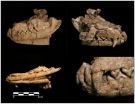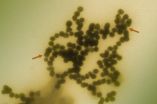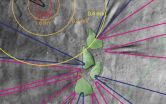(Press-News.org) TORONTO, ON – Anthropologists at the University of Toronto and the University of Cambridge have discovered the oldest cemetery in the Middle East at a site in northern Jordan. The cemetery includes graves containing human remains buried alongside those of a red fox, suggesting that the animal was possibly kept as a pet by humans long before dogs ever were.
The 16,500-year-old site at 'Uyun al-Hammam was discovered in 2000 by an expedition led by University of Toronto professor Edward (Ted) Banning and Lisa Maher, an assistant professor of anthropology at U of T and research associate at the University of Cambridge. "Recent archaeological excavations have uncovered the remains of at least 11 individuals – more than known from all other sites of this kind combined," says Banning, of U of T's Department of Anthropology.
Previous research had identified the earliest cemeteries in the region in a somewhat later period (the Natufian, ca. 15,000-12,000 years ago). These were notable for instances of burials of humans with dogs. One such case involved a woman buried with her hand on a puppy, while another included three humans buried with two dogs along with tortoise shells. However, this new research shows that some of these practices occurred earlier.
Most of the individuals buried at the Jordan site were found with what are known as "grave goods," such as stone tools, a bone spoon, animal parts, and red ochre (an iron mineral). One grave contained the skull and right upper arm bone of a red fox, with red ochre adhered to the skull, along with bones of deer, gazelle and wild cattle. Another nearby grave contained the nearly complete skeleton of a red fox, missing its skull and right upper arm bone, suggesting that portions of a single fox had been moved from one grave to another in prehistoric times.
"What we appear to have found is a case where a fox was killed and buried with its owner," says Maher, who directs excavations at the site. "Later, the grave was reopened for some reason and the human's body was moved. But because the link between the fox and the human had been significant, the fox was moved as well."
The researchers say that it could suggest that foxes were at one time treated in much the same way as dogs, in that there could have been early attempts to tame foxes, but no successful domestication. Studies have shown that foxes can be brought under human control but is not easily done given their skittish and timid nature, which may explain why dogs ultimately achieved "man's best friend" status instead.
"However, it is also noteworthy that the graves contain other animal remains, so we can only take the fox-dog analogy so far," says Banning. "We should remember that some more recent hunter-gatherers consider themselves to have social relationships with a wide range of wild animals, including ones they hunt, and that this sometimes led to prescribed ways to treat the remains of animals, as well as to represent relationships between particular humans and particular animals." Banning says that the "pet" hypothesis is only one among several, which happens to fit with modern preconceptions about human-dog relationships.
Either way, because the same grave that held the fox remains also contained other bones, Banning says that the find holds important clues about burial methods of civilizations past.
"These were unusually dense and diverse concentrations of bones, and indicate very early mortuary practices that involved interring selected animal remains with humans," says Banning. "The site has implications both for our understanding of the development of ideas about death and mortuary practice, and for our understanding of the beginnings of domestication of dog-like animals."
INFORMATION:
Details of the find were published recently in a paper titled "A Unique Human-Fox Burial from a Pre-Natufian Cemetery in the Levant (Jordan)" in the online journal PLoS One . Fieldwork and research by Banning, Maher and colleagues was partly funded by the Social Sciences and Humanities Research Council of Canada and a National Geographic Research Exploration Grant.
The paper can be viewed at http://www.plosone.org/article/info%3Adoi%2F10.1371%2Fjournal.pone.0015815.
MEDIA CONTACTS:
Edward (Ted) Banning
Department of Anthropology
University of Toronto
ted.banning@utoronto.ca
416-978-2315
Lisa Maher
Leverhulme Centre for Human Evolutionary Studies
University of Cambridge
l.maher@human-evol.cam.ac.uk
+44 784 291 8988
Sean Bettam
Communications, Faculty of Arts & Science
University of Toronto
s.bettam@utoronto.ca
416-946-7950
University of Toronto anthropologists discover earliest cemetery in Middle East
Evidence of emotional relationship between human and fox
2011-02-03
ELSE PRESS RELEASES FROM THIS DATE:
Uterine health more important than egg quality
2011-02-03
HOUSTON (Feb. 2, 2011) -- For women seeking pregnancy by assisted reproductive technologies, such as in-vitro fertilization (IVF), a new study shows that the health of the uterus is more relevant than egg quality for a newborn to achieve normal birth weight and full gestation. This study, published in Fertility and Sterility, an international journal for obstetricians, offers new information for women with infertility diagnoses considering options for conceiving.
The study was conducted by Dr. William Gibbons, director of The Family Fertility Program at Texas Children's ...
NIST technique controls sizes of nanoparticle clusters for EHS studies
2011-02-03
The same properties that make engineered nanoparticles attractive for numerous applications—small as a virus, biologically and environmentally stabile, and water-soluble—also cause concern about their long-term impacts on environmental health and safety (EHS). One particular characteristic, the tendency for nanoparticles to clump together in solution, is of great interest because the size of these clusters may be key to whether or not they are toxic to human cells. Researchers at the National Institute of Standards and Technology (NIST) have demonstrated for the first time ...
Neurobiologists find that weak electrical fields in the brain help neurons fire together
2011-02-03
Pasadena, Calif.—The brain—awake and sleeping—is awash in electrical activity, and not just from the individual pings of single neurons communicating with each other. In fact, the brain is enveloped in countless overlapping electric fields, generated by the neural circuits of scores of communicating neurons. The fields were once thought to be an "epiphenomenon, a 'bug' of sorts, occurring during neural communication," says neuroscientist Costas Anastassiou, a postdoctoral scholar in biology at the California Institute of Technology (Caltech).
New work by Anastassiou ...
Field study of smoggy inversions to end
2011-02-03
SALT LAKE CITY, Feb. 2, 2011 – During the past two months, researchers launched weather balloons, drove instrument-laden cars and flew a glider to study winter inversions that often choke Salt Lake City in smog and trap dirty air in other urban basins worldwide.
The field campaign – part of a three-year study by the University of Utah and other institutions – ends Monday, Feb. 7 as atmospheric scientists begin analyzing data they collected to learn how weather conditions contribute to inversions, which occur when warmer air aloft holds cold air ...
Accountable care at Academic Medical Centers: Lessons learned
2011-02-03
Academic Medical Centers (AMCs) must adjust and adapt to the new health care reform laws or risk marginalization in the new health care arena, according to a New England Journal of Medicine Perspective article published online February 2.
The authors of the article, Scott A. Berkowitz, M.D., M.B.A., a fellow in cardiology and geriatrics at the Johns Hopkins University School of Medicine, and Edward D. Miller, M.D., dean and CEO of Johns Hopkins Medicine, argue that AMCs can not only remain relevant in the face of sweeping change, but can lead the way by serving as examples ...
Neiker-Tecnalia creates air-conditioned greenhouse with alternative energies
2011-02-03
Neiker-Tecnalia (The Basque Institute for Agricultural Research and Development) has created an air-conditioned greenhouse using alternative energies that enable the reduction of energy costs, improvements in energy efficiency and an increase in crop yields. The novel system has a biomass boiler and thermodynamic solar panels, which reach an optimum temperature for the crop without using fuels derived from petroleum oil or gas.
Neiker-Tecnalia has installed a biomass boiler (using wood and other organic waste as fuel), together with thermodynamic panels, with the goal ...
Older adults often excluded from clinical trials
2011-02-03
Older individuals, who constitute a rapidly growing population in the United States, account for a disproportionate share of health care utilization and cost.
Yet more than half of clinical trials exclude people based on their age or age-related conditions, according to a new study by Robert Wood Johnson Foundation (RWJF) Clinical Scholars® at the University of Michigan.
"These findings are concerning because it means that doctors cannot be confident that clinical trial results apply to their older patients," says Donna Zulman, M.D., the study's lead author and a ...
First new C. difficile drug in a generation superior to existing treatments: Researchers
2011-02-03
Clostridium difficile infection (CDI) is a significant and growing problem in hospitals and other health care facilities, but no new drugs to treat the condition have been developed in several decades. However, a large-scale, phase 3 trial conducted by Canadian and U.S. researchers shows that the new antibiotic Fidaxomicin is superior to existing treatments, demonstrating a 45 percent reduction in recurrences vs. the existing licensed treatment. Their results were published in February, 2011 in The New England Journal of Medicine.
"There wasn't much interest in C. difficile ...
First evidence for a spherical magnesium-32 nucleus
2011-02-03
Elements heavier than iron come into being only in powerful stellar explosions, supernovae. During nuclear reactions all kinds of short-lived atomic nuclei are formed, including more stable combinations – the so-called magic numbers – predicted by theory. Yet here, too, there are exceptions: the islands of inversion. Headed by physicists from the Excellence Cluster Universe at the Technische Universitaet Muenchen (TUM), an international team of scientists has now taken a closer look at the island that was first discovered. They have now published their results in Physical ...
New nanoparticles make blood clots visible
2011-02-03
For almost two decades, cardiologists have searched for ways to see dangerous blood clots before they cause heart attacks.
Now, researchers at Washington University School of Medicine in St. Louis report that they have designed nanoparticles that find clots and make them visible to a new kind of X-ray technology.
According to Gregory Lanza, MD, PhD, a Washington University cardiologist at Barnes-Jewish Hospital, these nanoparticles will take the guesswork out of deciding whether a person coming to the hospital with chest pain is actually having a heart attack.
"Every ...
LAST 30 PRESS RELEASES:
Injectable breast ‘implant’ offers alternative to traditional surgeries
Neuroscientists devise formulas to measure multilingualism
New prostate cancer trial seeks to reduce toxicity without sacrificing efficacy
Geometry shapes life
A CRISPR screen reveals many previously unrecognized genes required for brain development and a new neurodevelopmental disorder
Hot flush treatment has anti-breast cancer activity, study finds
Securing AI systems against growing cybersecurity threats
Longest observation of an active solar region
Why nail-biting, procrastination and other self-sabotaging behaviors are rooted in survival instincts
Regional variations in mechanical properties of porcine leptomeninges
Artificial empathy in therapy and healthcare: advancements in interpersonal interaction technologies
Why some brains switch gears more efficiently than others
UVA’s Jundong Li wins ICDM’S 2025 Tao Li Award for data mining, machine learning
UVA’s low-power, high-performance computer power player Mircea Stan earns National Academy of Inventors fellowship
Not playing by the rules: USU researcher explores filamentous algae dynamics in rivers
Do our body clocks influence our risk of dementia?
Anthropologists offer new evidence of bipedalism in long-debated fossil discovery
Safer receipt paper from wood
Dosage-sensitive genes suggest no whole-genome duplications in ancestral angiosperm
First ancient human herpesvirus genomes document their deep history with humans
Why Some Bacteria Survive Antibiotics and How to Stop Them - New study reveals that bacteria can survive antibiotic treatment through two fundamentally different “shutdown modes”
UCLA study links scar healing to dangerous placenta condition
CHANGE-seq-BE finds off-target changes in the genome from base editors
The Journal of Nuclear Medicine Ahead-of-Print Tip Sheet: January 2, 2026
Delayed or absent first dose of measles, mumps, and rubella vaccination
Trends in US preterm birth rates by household income and race and ethnicity
Study identifies potential biomarker linked to progression and brain inflammation in multiple sclerosis
Many mothers in Norway do not show up for postnatal check-ups
Researchers want to find out why quick clay is so unstable
Superradiant spins show teamwork at the quantum scale
[Press-News.org] University of Toronto anthropologists discover earliest cemetery in Middle EastEvidence of emotional relationship between human and fox





